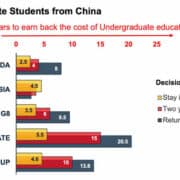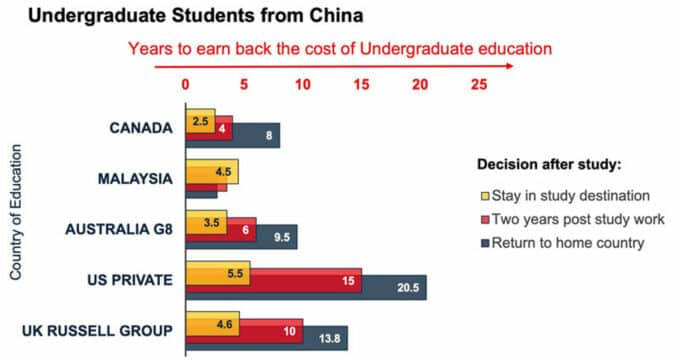Kenyan students staying home in greater numbers but quality concerns persist
Kenyan students are becoming less likely to leave their country for major study abroad destinations, and more likely to pursue higher education within Kenya. The reasons for the trend? The increasing cost of study abroad paired with expanded capacity in Kenyan higher education institutions. Kenya may be poised to be the next African higher education hub – but much will depend upon whether it can match this greater capacity with the necessary funding to elevate the quality of education provided by its institutions.
Outbound numbers drop
The number of outbound Kenyan students has declined over the past several years. UNESCO estimates there were just over 12,000 Kenyan students abroad in 2013, down from nearly 15,000 the year prior. The UNESCO statistics are largely concerned with the movement of Kenyan students to major study destinations overseas, and they indicate that more than half of the country’s outbound students went to the US, UK, and Australia in 2013. Within that group of leading destinations, the US has seen numbers of Kenyan students in its institutions fall off sharply over the past decade or more. Figures from the Institute of International Education (IIE) show that there were 3,072 Kenyan students enrolled with US universities in 2014/15, less than half of the 7,000 students recorded for 2004/05. There is a further aspect of Kenyan mobility, however, that is not well reflected in the UNESCO statistics and that has to do with the number of Kenyans studying outside the country in neighbouring East African states. Media reports have it that tens of thousands more Kenyan students are enrolled in nearby countries, notably Tanzania and Uganda, the latter which has long been seen as an education hub in the area. This, too, may be starting to shift: reports from 2014 indicate that the number of Kenyan students in Uganda have begun to decline. It appears that Kenyan students are simply opting to study at home in greater numbers than has been the case in the past. The costs of study abroad for Kenyan students, particularly in the US, have increased over time, in part due to a decline in the value of the Kenyan shilling against major foreign currencies. But the higher education system in Kenya has also expanded rapidly over the past decade and the country has considerably more university spaces today then it did at the turn of the century.
Rapid expansion at home
There are now 68 higher education institutions in Kenya, up from 58 since 2011 alone. Twenty-two are public and the rest – which are responsible for the greatest expansion in Kenya's higher education capacity – are private. The country needs this additional capacity as the massification of higher education in Kenya is now in full effect. Total enrolment has grown very quickly from 2012 on, doubling between 2012 and 2014 alone. From 2013’s 361,379 students, higher education enrolment grew to 443,783 in 2014 and then, more modestly, to reach 470,152 students in 2015. Few countries could see their enrolment expand so quickly without significant quality challenges, and Kenya is no exception in this regard. Quartz Africa reported earlier this month that Kenya’s Commission of University Education (CUE) recently closed ten of 13 branches of Kisii University due to quality concerns, and adds, "The quality of Kenyan universities, whether at branch level or at major, established campuses, is slipping. This process has accelerated in the past 20 years and it requires urgent work from the higher education sector and government to arrest the decline." Another recent item from the Daily Nation newspaper highlights a 2015 World Bank study that raised the alarm as to the quality and employability of graduates being produced by Kenyan universities. One of the key areas of concern for the World Bank was the level of funding allocated to higher education institutions in the country. At the same time as enrolments have grown so significantly over the past five years, the higher education system has also had to absorb cuts in public funding. Total government spending on higher education was reduced by 6% in 2015/16 compared to the year before. It was recently announced that spending for 2016/17 will increase by 3.5%, but while this is an improvement on the previous year’s reduction in funding, the 3.5% will not keep pace with underlying increases in operating costs. Inflation in Kenya is pegged at about 10% currently, so institutions will lose ground again this year even with the modest budget increment planned for the coming fiscal year. In a further twist, the government appears to be looking to international revenues as a means to offset funding challenges for local institutions. It has removed visa requirements for students from neighbouring East African Community states, including Burundi, Rwanda, Uganda, and Tanzania, and Kenya appears poised to take up the mantle of regional education hub previously held by Uganda.
The big question
Put those two trends – a recent-year decline in outbound mobility and a rapid expansion of higher education enrolment at home – together with yet another interesting characteristic of the Kenyan market: population growth. Forecasts indicate that Kenya will have one of the world’s fastest-growing populations of 18-to-22-year-olds through 2024. The British Council projects that Kenya will have a population of 5.7 million college-aged students by 2024, up from 4.2 million in 2011 – a level of growth exceeded only by Nigeria, India, Ethiopia, and Indonesia. Overall outbound mobility ratios for Kenya – a British Council calculation that balances population growth with forecasted income growth, foreign exchange rates, and domestic capacity – are nevertheless expected to dip from 7% of college-aged students in 2011 to 5% in 2024. But even if that ratio nudges downward as forecast, it will do so against a larger base of 18-to-22-year-olds. The quality of domestic education, and how local labour markets respond to the perceived quality of graduates of Kenyan institutions, will be an important wild card in shaping demand for study abroad in the country over the next decade. All of these factors make Kenya an important market to watch over the next few years, particularly as other important emerging markets in Africa, most notably Nigeria, continue to play a larger role in international mobility.


















